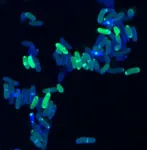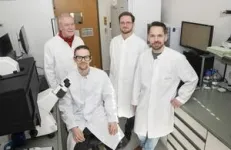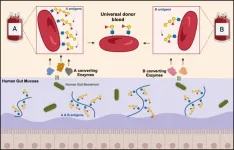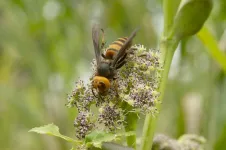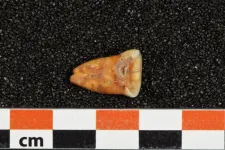(Press-News.org) Many bacteria produce substances to gain an advantage over competitors in their highly competitive natural environment. Researchers at the University Hospital Bonn (UKB), the University of Bonn and the German Center for Infection Research (DZIF) have discovered a new so-called lantibiotic, namely epilancin A37. It is produced by staphylococci that colonize the skin and acts specifically against their main competitors there, the corynebacteria. This specificity is presumably mediated by a very special mechanism of action, which the researchers were able to decipher in detail. Their results have now been published in the renowned ISME Journal.
Due to increasing antibiotic resistance in pathogens causing infections, the development of new antibacterial substances is important. Hopes are pinned on a new group of substances produced by gram-positive bacteria, the lantibiotics. These are antimicrobial peptides that often have a very narrow spectrum of activity. "Such compounds are highly interesting from a medical point of view, as they could specifically attack individual groups of organisms without affecting the entire bacterial flora, as is the case with broad-spectrum antibiotics, for example," says corresponding author Dr. Fabian Grein, until recently head of the DZIF research group "Bacterial Interference" at the Institute of Pharmaceutical Microbiology at the UKB and member of the Transdisciplinary Research Area (TRA) "Life & Health" at the University of Bonn.
Essential competitive advantage over corynebacteria
The UKB research team led by Fabian Grein and Tanja Schneider, together with the team led by Ulrich Kubitscheck, Professor of Biophysical Chemistry at the University of Bonn, have now discovered a new lantibiotic, namely epilancin A37. It is produced by staphylococci, which are typical colonizers of the skin and mucous membranes. Little is known about these antimicrobial peptides. "We were able to show that epilancins are widespread in staphylococci, which underlines their ecological importance," says first author Jan-Samuel Puls, a doctoral student from the University of Bonn at the Institute of Pharmaceutical Microbiology at the UKB. This is because staphylococci and corynebacteria are important genera of the human microbiota - i.e. the totality of all microorganisms such as bacteria and viruses - in the nose and skin, which are closely linked to health and disease. The need to produce such a compound indicates a pronounced competition between the species. The researchers were able to show that the newly discovered epilancin A37 acts very specifically against corynebacteria, which are among the main competitors of staphylococci within the skin microbiome.
New mode of action in the "bacterial war" decoded
"This specificity is presumably mediated by a very special mechanism of action that we were able to decipher in detail," says Grein. Epilancin A37 penetrates the corynebacterial cell, initially without destroying it. The antimicrobial peptides accumulate in the cell and then dissolve the cell membrane from the inside, thus killing the corynebacterium. Co-author Dr. Thomas Fließwasser from the Institute of Pharmaceutical Microbiology at the UKB, postdoctoral researcher at the University of Bonn and acting head of the DZIF research group "Bacterial Interference" adds: "Our study shows how a specific mechanism of action can be used to specifically combat a single bacterial species. It therefore serves us as a 'proof of concept'".
Promotion:
This project was funded by the German Center for Infection Research and the Transregio SFB TRR 261 "Antibiotic CellMAP" of the German Research Foundation.
END
Possible alternative to antibiotics produced by bacteria
Antibacterial substance from staphylococci discovered with new mechanism of action against natural competitors
2024-04-29
ELSE PRESS RELEASES FROM THIS DATE:
Quantitative study assesses how gender and race impact young athletes’ perceptions of their coaches
2024-04-29
Quantitative study assesses how gender and race impact young athletes’ perceptions of their coaches
Across the U.S., there are over 8 million student-athletes in high school and college. Engaging in sports can contribute to physical, mental, and social benefits, and coaches can play a key role in student-athletes’ continued participation in sports.
A recent study led by UNC Greensboro’s Dr. Tsz Lun (Alan) Chu, published in Sport, Exercise, and Performance Psychology, examines how multiple aspects of a young athlete’s ...
Enzymes open new path to universal donor blood
2024-04-29
The quest to develop universal donor blood has taken a decisive step forward. Researchers at DTU and Lund University have discovered enzymes that, when mixed with red blood cells, are able to remove specific sugars that make up the A and B antigens in the human ABO blood groups. The results have been published in the scientific journal Nature Microbiology.
"For the first time, the new enzyme cocktails not only remove the well-described A and B antigens, but also extended variants previously not recognized as problematic for transfusion safety. We are close to being able to produce universal blood from group B donors, while there is still work to be done to convert ...
Gemini south reveals origin of unexpected differences in giant binary stars
2024-04-29
It is estimated that up to 85% of stars exist in binary star systems, some even in systems with three or more stars. These stellar pairs are born together out of the same molecular cloud from a shared abundance of chemical building blocks, so astronomers would expect to find that they have nearly identical compositions and planetary systems. However, for many binaries that isn’t the case. While some proposed explanations attribute these dissimilarities to events occurring after the stars evolved, a team of astronomers have confirmed for the first time that they can actually originate ...
Hornets found to be primary pollinators of two Angelica species
2024-04-29
Researcher Ko Mochizuki of the University of Tokyo discovered that two species in the genus Angelica are pollinated primarily by hornets. This overturns the conventional belief that Angelica species are “generalists,” meaning that there is not one primary pollinator but a variety of species. As hornets are rarely primary pollinators, the discovery also impacts future ecological research and conservation efforts. The findings were published in the journal Ecology.
White, small, open, secretes nectar and produces pollen: these are the kinds of flowers that many types of insects can reach ...
Aspirin vs placebo as adjuvant therapy for breast cancer
2024-04-29
About The Study: In this randomized, placebo-controlled clinical trial that included 3,020 patients with high-risk nonmetastatic breast cancer, daily aspirin therapy did not improve risk of breast cancer recurrence or survival in early follow-up. Despite its promise and wide availability, aspirin should not be recommended as an adjuvant breast cancer treatment.
Authors: Wendy Y. Chen, M.D., of the Dana Farber Cancer Institute in Boston, is the corresponding author.
To access the embargoed study: Visit our For The Media ...
Association of new-onset seizures with SARS-CoV-2 vaccines
2024-04-29
About The Study: This systematic review and meta-analysis showed that the incidence proportion of new-onset seizures after SARS-CoV-2 vaccination was not statistically different between vaccine recipients and placebo recipients or unvaccinated participants in the pooled analyses of more than 118,000 participants in randomized clinical trials.
Authors: Churl-Su Kwon, M.D., M.P.H., of Columbia University in New York, is the corresponding author.
To access the embargoed study: Visit our For The Media website at this link https://media.jamanetwork.com/
(doi:10.1001/jamaneurol.2024.0967)
Editor’s Note: Please see the article for additional information, including ...
How can forests be reforested in a climate-friendly way?
2024-04-29
Europe's forests have already been severely affected by climate change. Thousands of hectares of trees have already died due to drought and bark beetles. Scientists from the University of Vienna and the Technical University of Munich TUM have now investigated which trees can be used for reforestation. Their findings: only a few tree species are fit for the future, such as English oak in the UK. However, mixed forests are important for the survival of forests, otherwise the forest ecosystem as a whole could be weakened. The results of the study were recently published in the renowned journal Nature Ecology and Evolution.
Although European forests are naturally home to a ...
More plants on the menu of ancient hunter-gatherers
2024-04-29
Conducted by an international team of scientists from the Max Planck Institute for Evolutionary Anthropology (Leipzig, Germany), Géoscience et Environnement Toulouse (Toulouse, France), and the Institut National des Sciences de l’Archéologie et du Patrimoine (Rabat, Morocco), the study examines the diet of individuals associated with the Iberomaurusian culture discovered in the cave of Taforalt, Morocco. Using a comprehensive multi-isotopic approach, including zinc and strontium isotope analysis in dental enamel, carbon, nitrogen, ...
The aspirin conundrum: navigating negative results, age, aging dynamics and equity
2024-04-29
WASHINGTON – A new study examining the role of aspirin in breast cancer treatment reveals critical issues related to health equity and aging that have broad implications for cancer and other disease intervention trials, say researchers from Georgetown University’s Lombardi Comprehensive Cancer Center. They outline their concerns in an editorial accompanying the study’s findings published April 29 in the JAMA (“The Aspirin Conundrum: Navigating Negative Results, Age, Aging Dynamics and Equity”).
The ...
Cancer screening rates are significantly lower in US federally qualified health centers
2024-04-29
HOUSTON and ALBUQUERQUE, N.M. ― A national study led by researchers at The University of Texas MD Anderson Cancer Center and The University of New Mexico (UNM) Comprehensive Cancer Center found major gaps in breast, cervical and colorectal cancer screening use in Federally Qualified Health Centers (FQHCs) in the U.S., relative to overall screening rates in the country.
The findings, published today in JAMA Internal Medicine, revealed screening use in FQHCs was 45.4% for breast cancer, 51% for cervical cancer and 40.2% for colorectal cancer, compared to cancer screening rates in the general American population of 78.2%, 82.9% and 72.3%, respectively.
“FQHCs ...
LAST 30 PRESS RELEASES:
Tracing the quick synthesis of an industrially important catalyst
New software sheds light on cancer’s hidden genetic networks
UT Health San Antonio awarded $3 million in CPRIT grants to bolster cancer research and prevention efforts in South Texas
Third symposium spotlights global challenge of new contaminants in China’s fight against pollution
From straw to soil harmony: International team reveals how biochar supercharges carbon-smart farming
Myeloma: How AI is redrawing the map of cancer care
Manhattan E. Charurat, Ph.D., MHS invested as the Homer and Martha Gudelsky Distinguished Professor in Medicine at the University of Maryland School of Medicine
Insilico Medicine’s Pharma.AI Q4 Winter Launch Recap: Revolutionizing drug discovery with cutting-edge AI innovations, accelerating the path to pharmaceutical superintelligence
Nanoplastics have diet-dependent impacts on digestive system health
Brain neuron death occurs throughout life and increases with age, a natural human protein drug may halt neuron death in Alzheimer’s disease
SPIE and CLP announce the recipients of the 2025 Advanced Photonics Young Innovator Award
Lessons from the Caldor Fire’s Christmas Valley ‘Miracle’
Ant societies rose by trading individual protection for collective power
Research reveals how ancient viral DNA shapes early embryonic development
A molecular gatekeeper that controls protein synthesis
New ‘cloaking device’ concept to shield sensitive tech from magnetic fields
Researchers show impact of mountain building and climate change on alpine biodiversity
Study models the transition from Neanderthals to modern humans in Europe
University of Phoenix College of Doctoral Studies releases white paper on AI-driven skilling to reduce burnout and restore worker autonomy
AIs fail at the game of visual “telephone”
The levers for a sustainable food system
Potential changes in US homelessness by ending federal support for housing first programs
Vulnerability of large language models to prompt injection when providing medical advice
Researchers develop new system for high-energy-density, long-life, multi-electron transfer bromine-based flow batteries
Ending federal support for housing first programs could increase U.S. homelessness by 5% in one year, new JAMA study finds
New research uncovers molecular ‘safety switch’ shielding cancers from immune attack
Bacteria resisting viral infection can still sink carbon to ocean floor
Younger biological age may increase depression risk in older women during COVID-19
Bharat Innovates 2026 National Basecamp Showcases India’s Most Promising Deep-Tech Ventures
Here’s what determines whether your income level rises or falls
[Press-News.org] Possible alternative to antibiotics produced by bacteriaAntibacterial substance from staphylococci discovered with new mechanism of action against natural competitors
